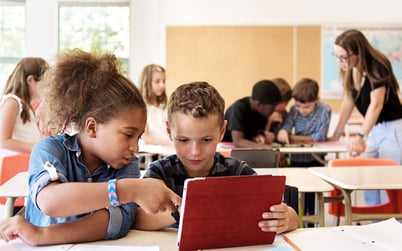6 Ways to Set Up Inclusion Settings Successfully for Autistic Students
Defining inclusion:
Inclusion is a common term used in education, meaning to bring together all students regardless of their abilities. An inclusion setting allows students with disabilities to learn and socialize alongside their non-disabled peers. Successful inclusion opportunities are dependent on the needs of the students.
Importance of inclusion:
There are many positive benefits to having students with disabilities participate with non-disabled peers. The Individuals with Disabilities Education Act (IDEA) states that students with disabilities must be educated in the “Least Restrictive Environment” (LRE). As educators, we need to ensure that our students are learning in the least restrictive environment. Setting up inclusion opportunities encourages LRE. Inclusion doesn’t require special education students to be in a general education classroom all day. This could be very stressful for some autistic students, but we need to reflect and develop the best opportunities possible for inclusion because there can be many benefits for all students.
 Inclusion encourages socialization. Our job as educators is to ensure that our students are prepared for the real world. To be ready for the real world, our autistic students must interact successfully with neurotypical individuals. A successful inclusion program will also help students develop friendships with individuals that they wouldn’t have access to otherwise. Ideally, this will also lead to acceptance.
Inclusion encourages socialization. Our job as educators is to ensure that our students are prepared for the real world. To be ready for the real world, our autistic students must interact successfully with neurotypical individuals. A successful inclusion program will also help students develop friendships with individuals that they wouldn’t have access to otherwise. Ideally, this will also lead to acceptance.
Inclusion could be detrimental if not done correctly. Autistic students require specific teaching strategies and structure. Often individuals on the spectrum struggle with communication and can become overwhelmed in a large classroom setting. The needs of the student should come first and should be carefully taken into consideration when coming up with a plan for inclusion.
Collaborate:
When developing a plan to include an autistic student with their general education peers, there needs to be a collaboration between the special education teacher and the general education teacher. Inclusion should be done according to a student’s grade. A 7th-grade autistic student shouldn’t be participating in a 1st-grade general education class. We need to collaborate with the appropriate staff within the student’s grade to ensure a decisive learning or social outcome.
It’s helpful to have self-contained teachers be part of relevant grade-level teams and meetings. Unfortunately, self-contained teachers can sometimes be forgotten and left in their own little bubbles. If you are a self-contained teacher and are not part of the grade-level meetings, you need to speak up and ask to be included to advocate for your students. Once you are part of the team, you can discuss appropriate inclusion opportunities, instructional strategies, acceptance, learning targets, curriculum implementation, behavioral supports, and scheduling. Working collaboratively with other teachers takes time, planning, and prescience. However, when collaboration is done effectively and respectfully, students will make strides that they would not be able to make otherwise.
Teach Acceptance:
 To have inclusion work successfully, you need to ensure that the environment is conducive to the acceptance of autistic individuals. Neurodivergent individuals should not be pitied or looked down upon because of a diagnosis. When included, they should receive dignity and respect when learning with peers. Teaching acceptance to children in our class is crucial. Yet, we need to model acceptance daily to ensure that the students understand tolerance. Having open conversations with our students about disabilities and differences is a great way to create a supportive and kind classroom environment.
To have inclusion work successfully, you need to ensure that the environment is conducive to the acceptance of autistic individuals. Neurodivergent individuals should not be pitied or looked down upon because of a diagnosis. When included, they should receive dignity and respect when learning with peers. Teaching acceptance to children in our class is crucial. Yet, we need to model acceptance daily to ensure that the students understand tolerance. Having open conversations with our students about disabilities and differences is a great way to create a supportive and kind classroom environment.
Know your student:
To set up an inclusive environment for your autistic student, you need to identify their options. What inclusion opportunity is conducive to their learning and offers appropriate opportunities for meaningful socialization? Some neurodivergent students can be mainstreamed for academic instruction with proper support in place. In contrast, other autistic students may not attend during academic instruction but could be included during specials, recess, or classroom parties. While working with autistic students, we need to consider each student’s needs and abilities and find the appropriate inclusive placement.
Set up Supports:
To adequately set up inclusion opportunities for our students, we need to accommodate their needs. Proper support needs to be in place once a student starts an inclusion schedule. We can provide support by guaranteeing that team members have designed a plan to meet students’ needs. Autistic students often benefit from a structured classroom and the scheduling of their day. We also need to consider transition cues, behavior interventions, differentiation of instruction, options for students to make choices, and options for students to ask for breaks when overwhelmed. All support we offer should be dependent on the needs of the neurodivergent student.
Be flexible:
Across all settings, we need to be accommodating and flexible to meet the needs of our learners. Finding the appropriate opportunities for inclusion can take trial and error. Flexibility drives inclusion. Both students and teachers must learn to tolerate change; we must explicitly teach our autistic students strategies that promote flexible thinking. While we work with other colleagues for inclusion, we must be flexible in our thinking and teaching approach. Changes may need to be made, and that’s ok, as long as it’s a team effort that keeps the student's specific needs in mind.
Reverse Inclusion:
Simply put, reverse inclusion is when general education students participate with special education students in a self-contained setting. Using reverse inclusion for specific autistic students can be very beneficial. Some of our neurodivergent students may struggle or become overwhelmed in large settings. Using reverse inclusion might be the perfect solution for those kiddos. Reverse inclusion should be done to encourage socialization and friendships. Creating these opportunities can be beneficial to both general education students and special education students alike.
 Autistic students should have the same opportunities to learn that their non-disabled peers are offered. Research indicates that when inclusion is done thoughtfully and carefully, the benefits can be immeasurable. Every individual is unique and should be appreciated for their differences. By personalizing inclusion plans students can thrive in inclusion settings.
Autistic students should have the same opportunities to learn that their non-disabled peers are offered. Research indicates that when inclusion is done thoughtfully and carefully, the benefits can be immeasurable. Every individual is unique and should be appreciated for their differences. By personalizing inclusion plans students can thrive in inclusion settings.
“To measure the success of our societies, we should examine how well those with different abilities, including autistic persons, are integrated as full and valued members.” – Ban Ki-Moon

Tatiana Tortora
Tatiana Tortora is a special education teacher in New York, specifically teaching students on the spectrum. She has her master’s degree in childhood education and students with disabilities. Tatiana is passionate about building understanding and acceptance of individuals with Autism.




